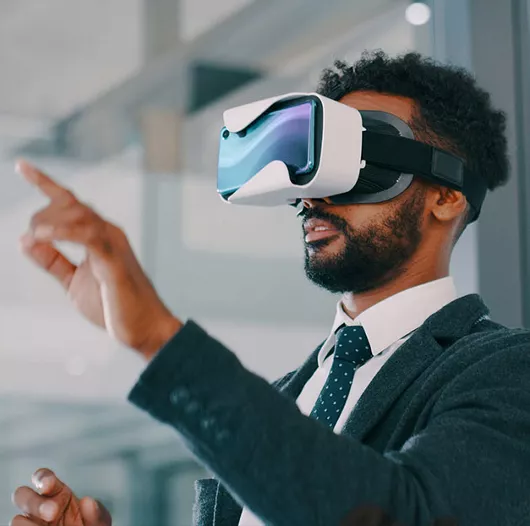Traversing the Metaverse With Lumada


Since Facebook changed its name to Meta and rebranded itself as a metaverse company, the financial and technical world has been abuzz with all things metaverse.
The metaverse describes the next iteration of the internet, a 3-D world in which humans will be able to engage and interact with others in virtual and or augmented realities. This metaverse will be fueled by data, a large part of which will come from connected internet of things (IoT) devices and sensors. In this new digital world, people are immersed within the environment and while there, can communicate, explore, purchase goods, manipulate objects, perform actions, and much more. From a business standpoint, a key value of virtual reality is the ability to lower risk. That is, whenever it is too dangerous, expensive, time-consuming, or impractical to do something in the physical world, the answer may be found in virtual reality. This ability will likely be greatly enhanced in the metaverse.
There are challenges. When constructed, these virtual realities must be based on true versions of reality, which themselves must be based on scientific principles and real-time data. If the virtual reality is based on corrupt or stale data, the results could be disastrous. This is where expert IT and OT data management and domain expertise will play an essential role.
Metaverse needs IT and OT data convergence to survive. Hitachi is one of the best companies to drive IT and OT data convergence, which requires:
Hitachi helps to ensure that we derive valid insights from real-world data that we can use to model virtual reality. Thanks to our deep domain knowledge across multiple industries combined with data intelligence and AI or ML modeling skills, we can provide what businesses need to address the Metaverse in the industrial space.
Hitachi has been leveraging virtual reality technologies for some time with Lumada, Hitachi’s data management platform for digital innovation. Lumada provides a complete software platform based on Hitachi’s expertise in building both IT and OT systems that power different industries. A core component of the Lumada platform is the asset avatar, a virtual representation of physical components. With asset avatars, also called “digital twins,” you can drive automation, predict and prevent costly outages, and move towards a fully automated business. The platform gives you a complete view of a single asset or a view of all your assets at once.
Here is an example of how the metaverse capabilities of Lumada are being used in the transportation business:

In a metaverse system, data obtained from the real world (physical spaces) is visualized and analyzed by AI or other technology running in a cloud in cyberspace. Based on the analysis, solutions to issues are fed back to the real world. Through the use of asset avatars or “digital twins” (technology that simulates the real world in cyberspace), we can now find ways to address changes in the real world with greater speed and a broader perspective than in the past.
By feeding this back to the real world, business sites are reborn as places where new value is continuously created even during great change. In the near future we will be able to add self-driving vehicles to provide further optimization.
Another enhancement would be the addition of smart contracts based on blockchain to simplify the contracting, invoicing and distribution process to avoid the supply chain blockage that the U.S. is currently facing today. The immutability nature of blockchain also eliminates the need for guesswork or financial negotiations.
These virtual assets are capable of delivering a wealth of data on their own. Augmented with the help of external sensors, this data can help organizations drive new levels of competitive growth and differentiation. While the growth of data has the potential to make organizations smarter, as smart asset data volume increases, so does the challenge of managing and utilizing this data. To make sense of this data, organizations are turning to IoT platforms to collect and decipher the captured intelligence. Companies in the industrial sector know they need IoT solutions that deliver fast time to value and help solve costly problems, such as unplanned downtime. The key to success lies in choosing the right solution to help organizations connect and manage assets.

A multiverse approach to asset management can build predictability into your process and operations. Digital models of physical systems can help you analyze complex systems and their interactions between people, processes, systems, and places. Your teams can use these insights to identify gaps and faults in equipment or processes that aren’t readily detectible, model the impact of changes before making them, and transform maintenance programs, among other gains. For example, manufacturers can combine digital twins with video, 3D lidar and connected equipment to guide technicians to machines needing repairs, as well as assist with issue diagnosis.
Hitachi’s Lumada IoT Platform provides a complete software platform based on Hitachi’s expertise in building both IT systems and the OT equipment that powers your industry. A core component of the Lumada IoT Platform is the asset avatar. See Hitachi’s ebook on how Lumada can be used in Your Guide to Building a Digital Advantage in Industry.
Hu Yoshida is CTO Emeritus at Hitachi Vantara.

Hu Yoshida spent 24 years at Hitachi Vantara helping define technical direction and enabling customers to address their digital transformation needs. He is widely known in the industry and was instrumental in evangelizing Hitachi's unique approach to storage virtualization.